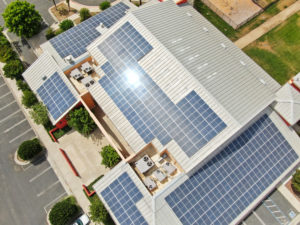A solar power system is made up of four elements:
 1) Solar panels made up of photovoltaic cells
1) Solar panels made up of photovoltaic cells
2) Racks that attach the panels to your roof
3) Electrical wiring and conduit
4) An inverter
Together, these are known as a solar array. A solar array uses the sun’s light as fuel.
Here’s how:
When the photons in the sun’s rays hit the photovoltaic (PV) cells in the solar panel, the material in the solar cells causes the photons to kick off electrons. Then the freed electrons are collected and channeled out of the solar module to become DC (direct current) electrical power. The inverter then converts this DC power into AC power, the type of power in the grid that standard appliances and electrical components use.
During daylight hours, your solar system generates electricity. Any power being produced and needed in your home flows into your home to be used. If your solar system generates more electricity than you need, your system sends the extra power to your utility, and you receive a credit on your bill for that power. If you use more power than your solar panels generate (at night, for example), you draw power from your utility as usual.
Net Metering
After we install your solar power system, your utility will change your single-direction meter to a bi-directional meter, or net meter. This allows excess energy that is produced during the daytime to flow back into the grid and be utilized by someone else, with an appropriate credit given to you. When it’s nighttime, you can recapture that energy “banked” in the grid.
